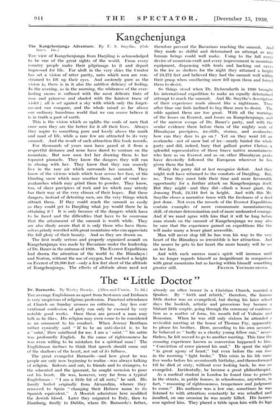Kangchenjunga
The Kangchenjunga Adventure. By F. S. Smythe. (Gol- lanez. les.)
Tus: view of Kangehenjunga from Darjiling is acknowledged to be one of the great sights of the world. From every country people make their pilgrimage to it and depart impressed for life. Far aloft in the very skies the Creator has set a vision of utter purity, unto which men are con- strained to lift up their eyes. And austerely pure as the vision is, there is in it also the subtlest delicacy of feeling. In the evening, as in the morning, the whiteness of the ever- lasting snows is suffused with the most delicate tints of rose and primrose and shaded with the faintest trace of violet ; all is set against a sky with which only the forget- me-not can compare, and the whole raised so far above our ordinary humdrum world that we can scarce believe it is in truth a part of earth.
This is the vision which so uplifts the souls of men that once seen they are the better for it all their lives. Always they aspire to something pure and lovely above the murk and mud of life, while a rare few are attracted to its very summit. And the result of such attraction this book records.
For thousands of years men have gazed at it from a respectful distance and none have dared to venture on the mountain. But now men feel her drawing them to her topmost pinnacle. They know the dangers they will run in closing with her. They know that they can scarcely live in the rare air which surrounds her summit. They. know of the vicious winds which tear across her face, of the blinding snow which may smother them, and of cruel ice- avalanches which may grind them to powder. They know, too, of sheer precipices of rock and ice which may utterly bar their way at the very climax of their hopes. But these dangers, instead of deterring men, are the very things which attract them. If they could reach the summit as easily as they could get to Darjiling what joy would there he in attaining it ? It is only because of the dangers which have to be faced and the difficulties that have to be overcome that the attainment of the summit is worth while. They are also dimly aware that it is only those who have them- selves grimly wrestled with great mountains who can appreciate the full glory of their beauty. And so they are drawn on.
The first really serious and properly organized assault on Kangehenjunga was made by Bavarians under the leadership of Dr. Bauer in the autumn of 1929. The Everest Expeditions had drawn the attention of the world to the Himalaya ; and Norton, without the use of oxygen, had reached a height on Everest of 28,100 feet—only a few feet short of the altitude of Kangehenjunga. The effects of altitude alone need not
therefore prevent the Bavarians reaching the summit. And they made as skilful and determined an attempt as any human beings could well make. Using to the full every device of mountain-craft and every improvement in mountain equipment, dispensing with tents and hacking out eaves in the ice as shelters for the night they attained a height of 24,272 feet and believed they had the summit well within their grasp when smothering snow fell upon them and forced them to desist.
So things stood when Dr. Dyhrenfurth in 1930 brought his international expedition to make an equally determined attempt to reach the summit. And Mr. Smythe's description of their experience reads almost like a nightmare. Time after time one feels inclined to beg these men to desist. The odds against them are too great. With all the warnings of the losses on Everest, and losses on Kangehenjunga, and of the narrow escape of Dr. Bauer's party, and with the ocular evidence there before them of the mighty scale of Himalayan precipices, ice-cliffs, storms, and avalanches how can they dare to go on ? Yet on they went till an avalanche—not of snow but of ice—nearly buried the whole party and did, indeed, bury that gallant porter Chetan. a splendid representative of. those brave native mountaineers who here as on Everest and as on other Himalayan peaks have devotedly followed the European wherever he has given them the lead.
Wisely the party did at last recognize defeat. And they might well have returned to the comforts of Darjiling. But, no. True they must bide their time and more favourable opportunity for a further attack on Kangehenjunga itself. But they might—and they did—climb a lesser giant, the Jonsong Peak, 24,344 feet in !might. And with this Mr. Smythe closes a narrative tense with the freshness of a deed just done. Not even the records of the Everest Expeditions contain examples of more consummate mountaineering skill, of sterner determination and of more undaunted courage. And if we must agree with him that it will be long before man stands on the summit of Kangchenjunga we may also be sure that the experience gained on expeditions like this will Make many a lesser giant accessible.
Man will never stop till he has won his way to the very heart of the Himalaya so irresistible is her attraction. And the nearer he gets to her heart the more beauty will he see on her face.
And with each success man's spirit will increase until he no longer regards himself as insignificant in comparison with great mountains but as having within himself something














































 Previous page
Previous page